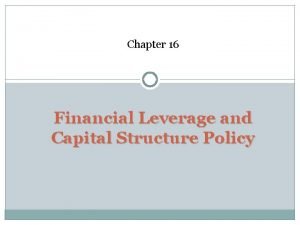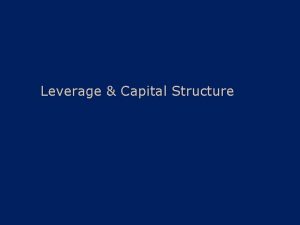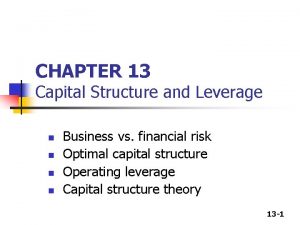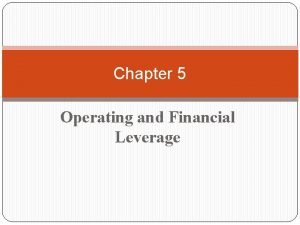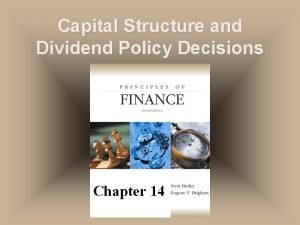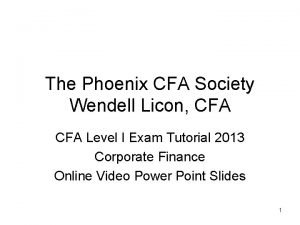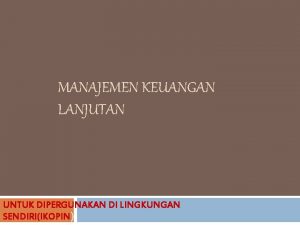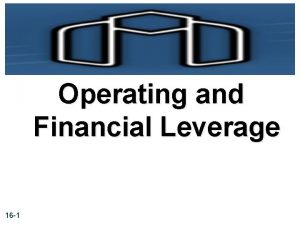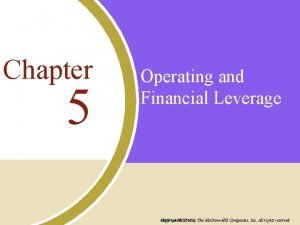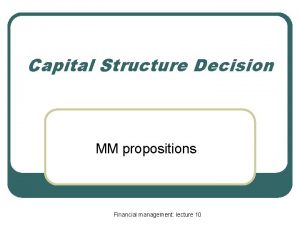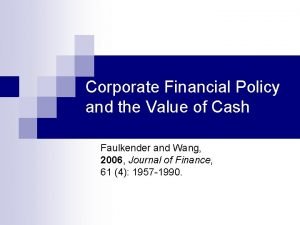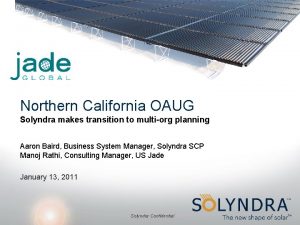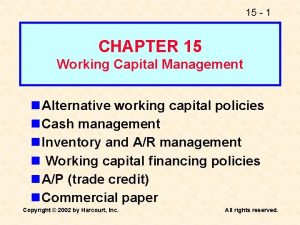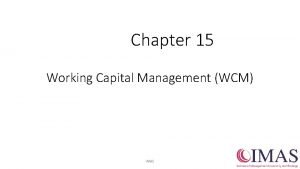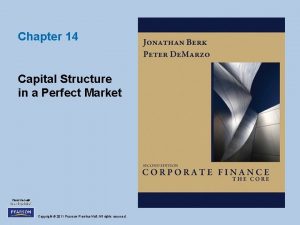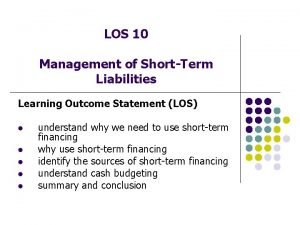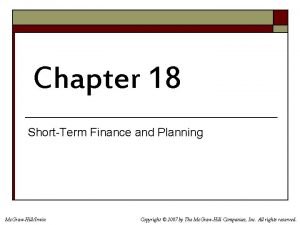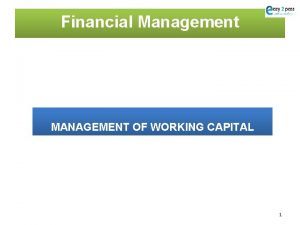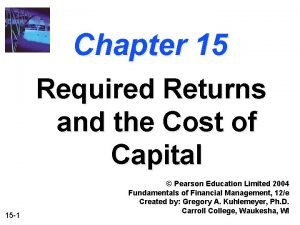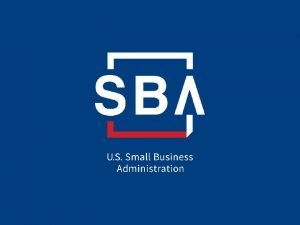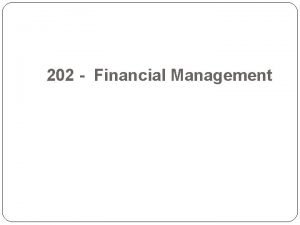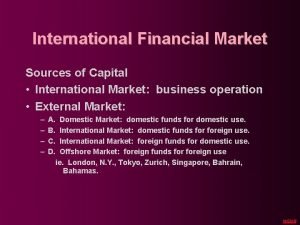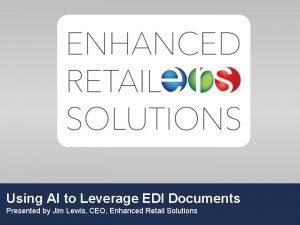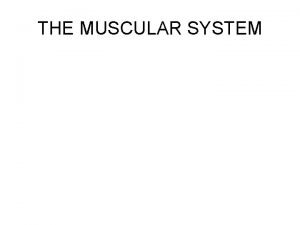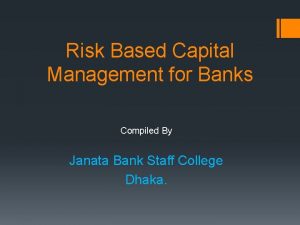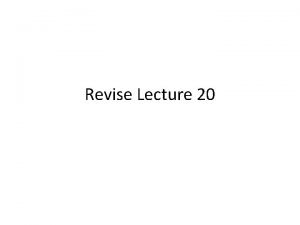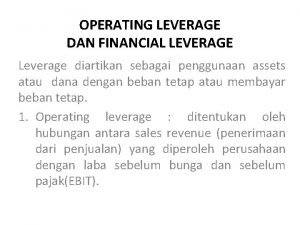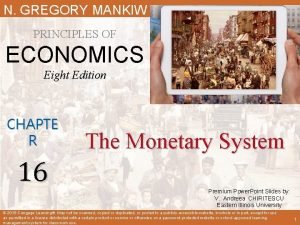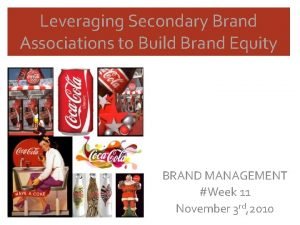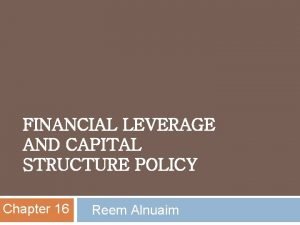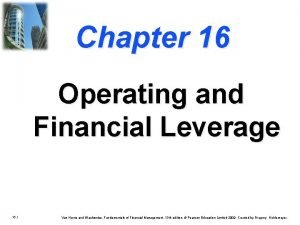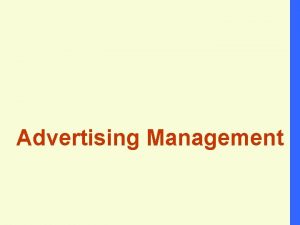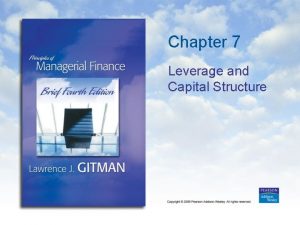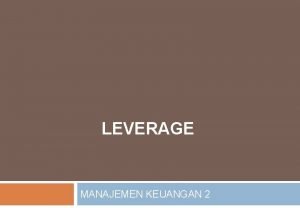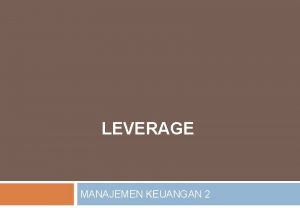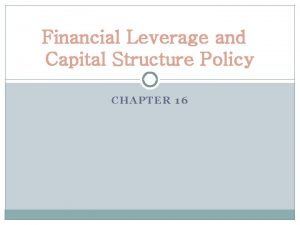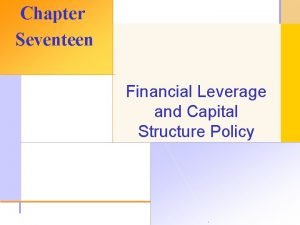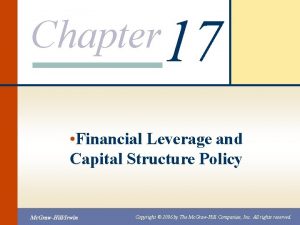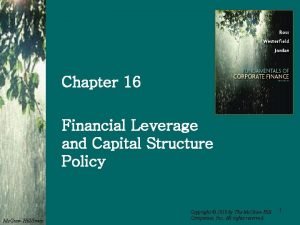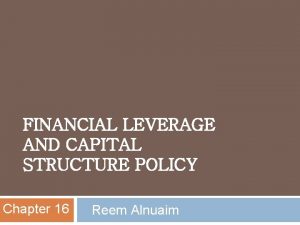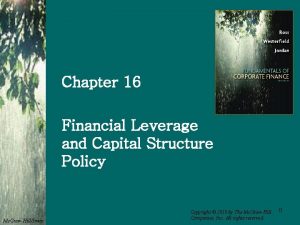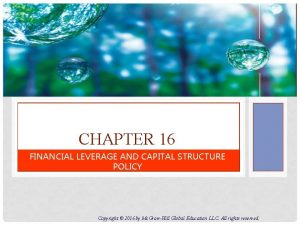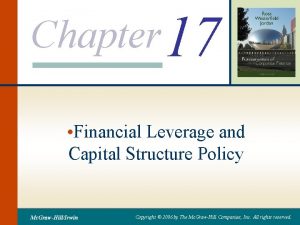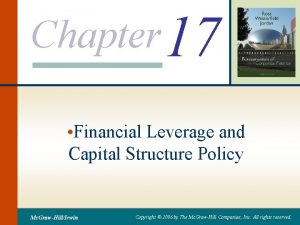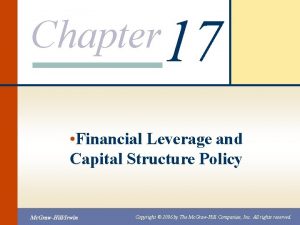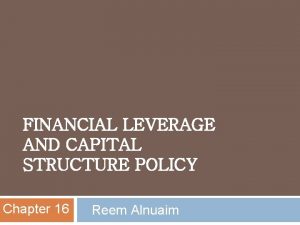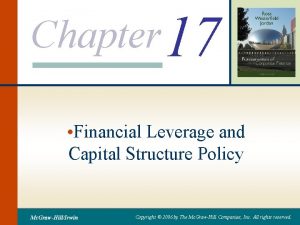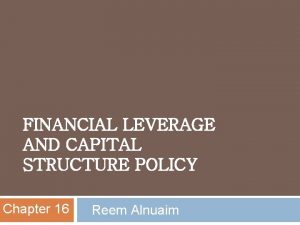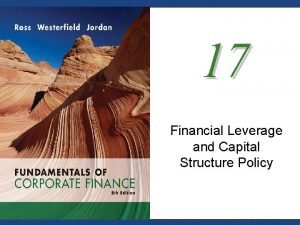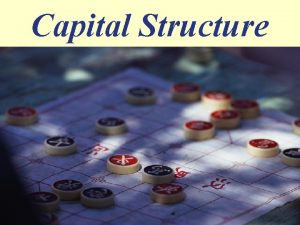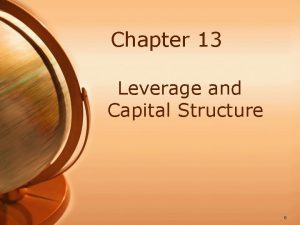Chapter 16 Financial Leverage and Capital Structure Policy

















































- Slides: 49

Chapter 16 • Financial Leverage and Capital Structure Policy Mc. Graw-Hill/Irwin Copyright © 2006 by The Mc. Graw-Hill Companies, Inc. All rights reserved.

Chapter Outline • • The Capital Structure Question The Effect of Financial Leverage Capital Structure and the Cost of Equity Capital M&M Propositions I and II with Corporate Taxes Bankruptcy Costs Optimal Capital Structure The Pie Again Observed Capital Structures 17 -1

Capital Restructuring • We are going to look at how changes in capital structure affect the value of the firm, all else equal • Capital restructuring involves changing the amount of leverage a firm has without changing the firm’s assets • The firm can increase leverage by issuing debt and repurchasing outstanding shares • The firm can decrease leverage by issuing new shares and retiring outstanding debt 17 -2

Choosing a Capital Structure • What is the primary goal of financial managers? • Maximize stockholder’s wealth • We want to choose the capital structure that will maximize stockholder wealth • We can maximize stockholder wealth by maximizing the value of the firm or minimizing the WACC 17 -3

The Effect of Leverage • How does leverage affect the EPS and ROE of a firm? • When we increase the amount of debt financing, we increase the fixed interest expense. • If we have a really good year, then we pay our fixed cost and we have more left over for our stockholders. • If we have a really bad year, we still have to pay our fixed costs and we have less left over for our stockholders. • Leverage amplifies the variation in both EPS and ROE 17 -4

Example: Financial Leverage, EPS and ROE – Part I • We will ignore the effect of taxes at this stage. • What happens to EPS and ROE when we issue debt and buy back shares of stock? 17 -5

Capital Restructuring Current Capital Structure Proposed Capital Structure Assets $5, 000, 000 Debt $0 $2, 500, 000 Market Value of Equity $5, 000 $2, 500, 000 D/E 0 1 Outstanding Shares 500, 000 250, 000 Share Price $10 Interest N. A. 10% 17 -6

Current Capital Structure: No Debt Recession Expected Expansion EBIT $300, 000 $650, 000 $1, 000 Interest 0 0 0 Net Income $300, 000 $650, 000 $1, 000 ROE 6. 00% 13. 0% 20. 0% EPS $0. 6 $1. 3 $2. 0 17 -7

Proposed Capital Structure: Debt=$2. 5 million Recession Expected Expansion EBIT $300, 000 $650, 000 $1, 000 Interest $250, 000 Net Income $50, 000 $400, 000 $750, 000 ROE 2. 00% 16. 0% 30. 0% EPS $0. 2 $1. 6 $3. 00 17 -8

Financial Leverage: EPS and EBIT 17 -9

Example: Financial Leverage, EPS and ROE – Part II • Variability in ROE • Current: ROE ranges from 6% to 20% • Proposed: ROE ranges from 2% to 30% • Variability in EPS • Current: EPS ranges from $0. 60 to $2. 00 • Proposed: EPS ranges from $0. 20 to $3. 00 • The variability in both ROE and EPS increases when financial leverage is increased. 17 -10

Break-Even EBIT • Find EBIT where EPS is the same under both the current and proposed capital structures. • If we expect EBIT to be greater than the break-even point, then leverage is beneficial to our stockholders. • If we expect EBIT to be less than the break -even point, then leverage is detrimental to our stockholders. 17 -11

Example: Break-Even EBIT 17 -12

Homemade Leverage • Individual investor can have the same leverage effect by borrowing money and buying stock. • The company does not have to change capital structure for a leverage effect. • Suppose that individual investors originally have 100 shares and no debt. Given that a stock price is $10, the market value of equity is equal to $1000. • Homemade leverage: Burrow $1000 and purchase additional 100 shares. Pay $100 as interest expenses. • • 10% interest rate is assumed. TA for individual = $2, 000 =200 shares x $10 per share Equity =$1000, Debt=$1, 000 D/E = 1 17 -13

Example: Homemade Leverage and ROE Recession Expected Expansion No Debt EPS =$ 0. 6 EPS=$1. 3 EPS=$2. 0 D/E =1 EPS= $0. 2 EPS=$1. 6 EPS=$3. 0 No leverage $60 (100 shares) $130 $200 D/E =1 $20 $160 $300 Homemade leverage $120 - $100 $260 -$100 =$20 =$160 $400$100=$300 17 -14

Capital Structure Theory • The value of the firm is determined by the cash flows to the firm and the risk of the assets. • Changing firm value • Change the risk of the cash flows. • Change cash flows. • Modigliani and Miller Theory of Capital Structure • Proposition I – Firm value is independent of the firm’s capital structure. • Proposition II – WACC does not change and cost of equity increase with D/E. 17 -15

Basic Assumption • We only focus on OCF. • It is reasonable to assume that capital spending and working capital are not influenced by change in capital structure. • No depreciation because depreciation does not influence the firm’s value when D/E changes. • Leveraged OCF= (EBIT – Interests) (1 -t) + Interests + Depreciation • Unleveraged OCF= (EBIT- 0) (1 -t)+ Deprecation • Leveraged OCF – Unleveraged OCF = t * Interests 17 -16

Capital Structure Theory Under Three Special Cases • Case I – Assumptions • No corporate or personal taxes • No bankruptcy costs • Case II – Assumptions • Corporate taxes, but no personal taxes • No bankruptcy costs • Case III – Assumptions • Corporate taxes, but no personal taxes • Bankruptcy costs 17 -17

Case I – Propositions I and II • MM Proposition I • The value of the firm is NOT affected by changes in the capital structure. • The cash flows of the firm do not change; therefore, value doesn’t change. • MM Proposition II • The WACC of the firm is NOT affected by capital structure. • Cost of equity is increased by increasing D/E. 17 -18

Case I - Equations • WACC = RA = (E/V)RE + (D/V)RD • RE = RA + (RA – RD)(D/E) • RA is the “cost” of the firm’s business risk, i. e. , the risk of the firm’s assets. • The risk of assets is independent of capital structure. • (RA – RD)(D/E) is the “cost” of the firm’s financial risk, i. e. , the additional return required by stockholders to compensate for the risk of leverage. • When D=0, RE is called as Ru where unleveraged firm’s cost of capital. 17 -19

Figure 16. 3 17 -20

Case I - Example • Information: Required return on assets = 16%, cost of debt = 10%; percent of debt to firm’s value = 45% • What is the cost of equity? • RE = 16 + (16 - 10)(. 45/. 55) = 20. 91% • Suppose instead that the percent of debt =60%. What is the cost of equity? • RE = 16 + (16 - 10)(. 6/. 4) = 16+9 =25 • Based on this information, how can you describe the relation between the cost of equity and the debt –equity ratio? • As the debt-equity ratio increases, the cost of equity increases. 17 -21

The CAPM, the SML and Proposition II • How does financial leverage affect the systematic risk? • CAPM: E(RA )= Rf + A(E(RM)– Rf) • Where A is the firm’s asset beta and measures the systematic risk of the firm’s assets. • WACC = RA = (E/V)RE + (D/V)RD • Replace returns of equity and debt with the CAPM • A= (E/V) E + (D/V) D 17 -22

Business Risk and Financial Risk • E = A+ ( A - D)D/E • Therefore, the systematic risk of the stock depends on: • Systematic risk of the assets, A, (Business risk) • Level of leverage, D/E, (Financial risk) • In case 1 (no taxes and no bankruptcy costs) • MM proposition I and II hold. • Cost of equity increases by D/E. • Systematic risk of equity increases by D/E. 17 -23

Case II – Cash Flow • Interest is tax deductible. • Therefore, when a firm adds debt, it reduces taxes, all else equal. • The reduction in taxes increases the cash flow of the firm. • How should an increase in cash flows affect the value of the firm? • Assume that the market value of Debt is $6, 250 and annual interest rate is 8%. 17 -24

Case II - Example Unlevered Firm EBIT Levered Firm 5000 0 500 Taxable Income Taxes (34%) 5000 4500 1700 1530 Net Income 3300 2970 OCF 3300 3470 Interest u We do not consider depreciation because it does not affect the result. 17 -25

Interest Tax Shield • Annual interest tax shield • Tax rate times interest payment • $6, 250 in 8% debt = $500 in interest expense • Assume that coupon rate is equal to YTM. • Annual tax shield =. 34(500) = 170 • Present value of annual interest tax shield • Assume perpetual debt for simplicity • PV = 170 /. 08 = 2125 • PV = D(RD)(TC) / RD = D TC = 6250(. 34) = 2125 17 -26

Case II – Proposition I • The value of the firm increases by the present value of the annual interest tax shield • Value of a levered firm = value of an unlevered firm + PV of interest tax shield • Assuming perpetual cash flows (EBIT (1 T)) • VU = EBIT(1 -T) / RU, RU is the cost of capital for the unleveraged firm. • VL = VU + DTC , DTC = D(RD)(TC) / RD =D Tc 17 -27

Example: Case II – Proposition I • Example • EBIT = 25 million; Tax rate = 35%; Debt = $75 million; Cost of debt = 9%; Unlevered cost of capital = 12% • EBIT and Debt are assumed to be perpetual. • VU = 25(1 -. 35) /. 12 = $135. 42 million • VL = 135. 42 + 75(. 35) = $161. 67 million • E = 161. 67 – 75 = $86. 67 million • Firm value increases by D/E, violating MM proposition I. 17 -28

Figure 16. 4 17 -29

Case II – Proposition II • The WACC decreases as D/E increases because of the government subsidy on interest payments • RA = (E/V)RE + (D/V)(RD)(1 -TC) --(1) • RA =RU [1 -TC (D/V)] = RU [E+(1 -TC)D]/V, ---(2) • RU is the cost of capital for unleveraged firm (all equity financed firm) • RA is the cost of capital (WACC) for leveraged firm. • [ Equation (2) comes from (VL = VU + DTC )]. • RE = RU + (RU – RD)(D/E)(1 -TC), by using (1) and (2). • Example (RU = 12, RD= 9), what is the leveraged firm’s cost of equity and WACC? • RE = 12 + (12 -9)(75/86. 67)(1 -. 35) = 13. 69% • RA = (86. 67/161. 67)(13. 69) + (75/161. 67)(9)(1 -. 35) RA = 10. 05% 17 -30

Example: Case II – Proposition II • Example • • • EBIT = 25 million; Tax rate = 35%; Cost of debt = 9%; Unlevered cost of capital = 12% • EBIT and Debt are assumed to be perpetual. • VL = 135. 42 + 75(. 35) = $161. 67 million, if D=75 Suppose that the firm changes its capital structure so that the debt-to-equity ratio becomes 1. D/E =1 VL = Vu + D t = $135. 42 + D (0. 35) = E + D = 2 D D = 82. 07 = E VL = 82. 07 (2) = 164. 14 • Since D/E increases, the firm’s value increases. 17 -31

WACC and the firm’s value • What will happen to the cost of equity under the new capital structure? (RU = 12, RD= 9) • RE = 12 + (12 - 9)(1)(1 -. 35) = 13. 95% • What will happen to the weighted average cost of capital? • RA =. 5(13. 95) +. 5(9)(1 -. 35) = 9. 9% • VL = EBIT (1 -t) / RA = 25 (1 -0. 35)/0. 099 = 164. 14 • VL = EBIT (1 -t)/Ru + D t = Vu + D t = EBIT (1 -t)/RA • When WACC is used, OCF should not consider tax shields of interests because the discount rate of WACC already considers tax shield. 17 -32

Figure 16. 5 17 -33

Case III • Now we add bankruptcy costs • As the D/E ratio increases, the probability of bankruptcy increases. • This increased probability will increase the expected bankruptcy costs. • At some point, the additional value of the interest tax shield will be offset by the increase in expected bankruptcy cost. • At this point, the value of the firm will start to decrease and the WACC will start to increase as more debt is added. 17 -34

Bankruptcy Costs • Financial distress • Significant problems in meeting debt obligations. • Most firms that experience financial distress do not ultimately file for bankruptcy. • Direct costs • Legal and administrative costs • Ultimately cause bondholders to incur additional losses • Disincentive to debt financing 17 -35

More Bankruptcy Costs • Indirect bankruptcy costs • Larger than direct costs, but more difficult to measure and estimate • Stockholders want to avoid a formal bankruptcy filing. • Bondholders want to keep existing assets intact so they can at least receive that money. • Assets lose value as management spends time worrying about avoiding bankruptcy instead of running the business. • The firm may also lose sales, experience interrupted operations and lose valuable employees. 17 -36

Figure 16. 6 17 -37

Figure 16. 7 17 -38

Figure 16. 8 17 -39

Conclusions • Case I – no taxes or bankruptcy costs • No optimal capital structure • Case II – corporate taxes but no bankruptcy costs • Optimal capital structure is almost 100% debt. • Each additional dollar of debt increases the cash flow of the firm. • Case III – corporate taxes and bankruptcy costs • Optimal capital structure is a certain combination of debt and equity. • Occur where the benefit from an additional dollar of debt is just offset by the increase in expected bankruptcy costs. 17 -40

Figure 16. 9 17 -41

The Total Value of the Firm • Total value of the firm = marketed claims + nonmarketed claims • Marketed claims are the claims of stockholders and bondholders. • Non-marketed claims are the claims of the government and other potential stakeholders. • The overall value of the firm is unaffected by changes in capital structure. • The division of value between marketed claims and non-marketed claims may be impacted by capital structure decisions. 17 -42

Observed Capital Structure • Capital structure does differ by industries. • Differences according to Cost of Capital 2000 Yearbook by Ibbotson Associates, Inc. • Lowest levels of debt • Drugs with 2. 75% debt • Computers with 6. 91% debt • Highest levels of debt • Steel with 55. 84% debt. • Department stores with 50. 53% debt. 17 -43

Announcement of Debt Issues • Stock price normally increases when a company announces unexpected debt issue. • Good news to the company who will issue debt. • This is not because of expected tax benefits but because of asymmetric information between the company and investors. • Why? • Signaling Hypothesis • The market interprets debt issue announcement as good news because investors expect that the company will have enough earnings in the future to cover the debt burden. -> The company has confidence about future earnings. • Misvaluation hypothesis • The company knows about valuation of its stock. When it believes that its stock is undervalued. It prefers debt to equity. 17 -44

Announcement of Equity Issues • It is exactly opposite to debt issues. • Stock price normally decreases when the company unexpectedly announces equity issues. • Why? • Signaling Hypothesis • The market interprets equity issue announcement as bad news because investors expect that the company will have enough earnings in the future to cover the debt burden. -> The company has confidence about future earnings. • Misvaluation hypothesis • The company knows about valuation of its stock. When it believes that its stock is overvalued. It prefers debt to equity 17 -45

Pecking Order Theory • Pecking order theory • Use internal financing first • Issue debt next • new equity last • Pecking order theory is based on asymmetric information about valuation of stock. • Since the effect of equity announcement on stock price is negative, the company does not like issue equity. • The pecking-order theory is in contrast to the optimal capital structure theory • there is no target D/E ratio • profitable firms will use less debt 17 -46

Quick Quiz • Explain the effect of leverage on EPS and ROE • How do we determine the optimal capital structure? • What is the optimal capital structure in the three cases that were discussed in this chapter? • What is the pecking order theory? • Effect of debt or equity announcement on stock price 17 -47

Chapter 16 • End of Chapter Mc. Graw-Hill/Irwin Copyright © 2006 by The Mc. Graw-Hill Companies, Inc. All rights reserved.
 Financial leverage and capital structure policy
Financial leverage and capital structure policy Capital structure leverage
Capital structure leverage The degree of operating leverage is
The degree of operating leverage is Chapter 13 leverage and capital structure gitman ppt
Chapter 13 leverage and capital structure gitman ppt Operating and financial leverage
Operating and financial leverage Business risk vs financial risk capital structure
Business risk vs financial risk capital structure Dividend policy and capital structure
Dividend policy and capital structure Multinational cost of capital and capital structure
Multinational cost of capital and capital structure Multinational cost of capital and capital structure
Multinational cost of capital and capital structure Degree of financial leverage formula
Degree of financial leverage formula Rumus dol, dfl dcl
Rumus dol, dfl dcl Wacc example
Wacc example Operating financial leverage
Operating financial leverage Financial leverage deals with
Financial leverage deals with M&m propositions
M&m propositions Fixed capital and working capital
Fixed capital and working capital Source of capital reserve
Source of capital reserve Difference between capital reserve and reserve capital
Difference between capital reserve and reserve capital Constant vs variable capital
Constant vs variable capital Corporate financial policy and the value of cash
Corporate financial policy and the value of cash Savers and investors role in financial markets
Savers and investors role in financial markets Financial markets and the allocation of capital
Financial markets and the allocation of capital Lift and leverage
Lift and leverage Working capital financing policy
Working capital financing policy Maturity matching working capital financing policy
Maturity matching working capital financing policy Capital structure in a perfect market
Capital structure in a perfect market Basle ii
Basle ii Regulatory capital vs economic capital
Regulatory capital vs economic capital Capital allocation line vs capital market line
Capital allocation line vs capital market line Financial and non financial methods of motivation
Financial and non financial methods of motivation Managing short term assets and liabilities
Managing short term assets and liabilities A flexible short term financial policy
A flexible short term financial policy Dividend policy decision in financial management
Dividend policy decision in financial management Dividend policy decision in financial management
Dividend policy decision in financial management Long term financing
Long term financing Cost of capital in financial management
Cost of capital in financial management Sba capital access financial system
Sba capital access financial system What is working capital in financial management
What is working capital in financial management Capital international financial
Capital international financial How to leverage edi
How to leverage edi Leg muscles
Leg muscles High leverage point vs outlier
High leverage point vs outlier Basel 3
Basel 3 Types of leverage
Types of leverage Cara menghitung dfl
Cara menghitung dfl Leverage ratio economics
Leverage ratio economics Sources of secondary brand associations
Sources of secondary brand associations Homemade leverage example
Homemade leverage example Types of leverage
Types of leverage Leverage point in advertising
Leverage point in advertising
